FOR SALE
A COLLECTION AMERICAN ARTS & CRAFTS ORIGINALS

These American Arts & Crafts originals are all guaranteed
to be as described, and are located in the USA. Please email for
further images, information and prices.
FURNITURE

Gustav Stickley 60" Bookcase
Near mint, hard to find 60" wide Gustav Stickley
two door bookcase with red decal and paper label.
Price $11,500.00 (JCF9)

Gustav Stickley Office Desk
Early Gustav Stickley Office Desk with chamfered
sides, keyed tenons, and large faceted square drawer pulls.
Price $5,800.00 (JCF8)
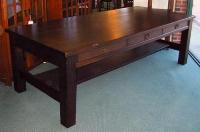
96" Gustav Stickley Library Table
Huge three drawer library table for a large office.
Fine new finish. 96" x 42" x 30 3/8" high
Price $8,500.00 (JCF7)
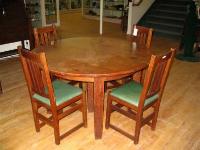
Gustav Stickley Dining Table
Gustav Stickley signed 54" diameter Round Oak
Dining Table with four original leaves. Original finish.
Price $5,750.00 (JCF6)
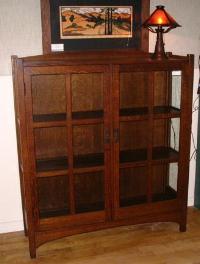
L & JG Stickley China Cabinet
L & JG Stickley China Cabinet in a fine original
finish. Rare form.
Price $6,800.00 (JCF5)
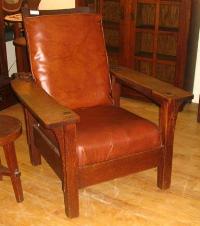
L & JG Stickley Paddle Arm Morris Chair
Rare L&JG Stickley Massive Paddle Arm Morris
Chair in a very fine original finish. Decal signature.
Price $11,500.00 (JCF4)
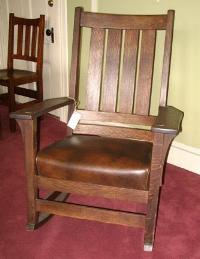
L & JG Stickley High Back Rocker
Model No. 836 Rocker by L&JG Stickley with new
leather seat cushion.
Price $1,250.00 (JCF3)
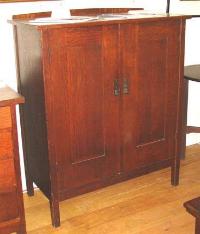
L & JG Stickley Chifferobe
Rare L & JG Chifferobe with fully drawered interior
in excellent original finish.
Price $8,500.00 (JCF2)
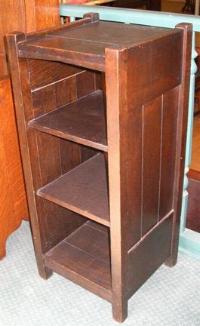
Gustav Stickley Early Magazine Stand
Unsigned circa 1901-02 original finish magazine
stand. Some roughness.
Price $5,750.00 (JCF1)

Gustav Stickley Bow Arm Morris Chair
This chair, though unsigned, is definitively by
Gustav Stickley. It is, we believe, a fairly early model as the
seat decking (redone) is caned and the dark color (fine original
finish) is indicative of earlier pieces. Replacement cushions.
A fine example of a scarce model morris chair.
Price on application (SW8)
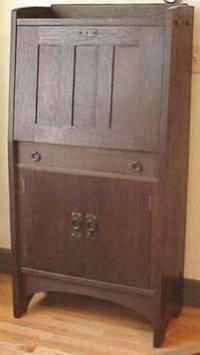
Gustav Stickley Cellarette
This signed Gustav Stickley cellarette is, by most
accounts, a very rare model indeed. Looking similar to a Gustav
drop front desk, this piece also has a drop front lid and a copper
work surface (replaced) for mixing/serving libation. The lower
two door cabinet provides a wine rack like arrangement for keeping
bottles. Professionally refinished. 52"H x 26"W x 14"D
Price on application (SW7)
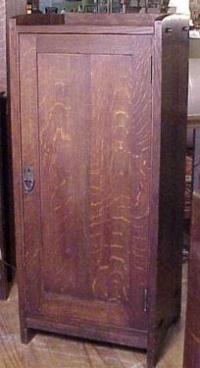
Gustav Stickley Music Cabinet
This twice signed (decal and paper label) Gustav
Stickley music cabinet is offered in fine originacondition. In
original finish as well, this piece is a medium brown color so
indigenous to many mid-period pieces. Pictured as model #70 in
the 1909 catalog, this cabinet measures: 46"H x 20"W
x 16"D / adjustable shelves
Price on application (SW6)

Gustav Stickley Spindle Sided Drop Arm Morris
Chair
This scarce model morris chair has long been considered
one of Gustav's better designed offerings. In excellent original
condition/color but for minimal color added to the top of the
arms where there had been wear from usage. Reupholstered in brown
leather.
Price on application (SW5)
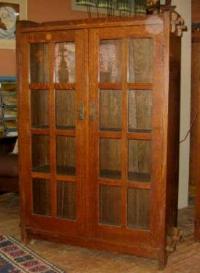
L & JG Stickley Two Door Bookcase
This signed L&JG Stickley bookcase is a scarcer
model than most, measuring only 36" in width and thus rendering
a sweet diminutive appearance. In fine original condition/color
this is a great example of a rare model; and even the original
key is present. Width: 36" / Height: 55" / Depth: 12"
Price on application (SW4)
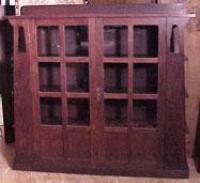
Limbert Two Door Bookcase
This bookcase is considered by many to be one of
Charles Limbert's finest designs, having cutout spade patterns
flanking each side; reminiscent of the Secessionist era. The splayed
sides of this case along with the cutouts, the gentle arches supporting
the top, and the simulated external bookshelves all complement
each other to make a very pleasing visual experience. Fine original
condition/finish but for the top of the bookcase which required
professional conservation of finish due to stains present when
we aquired this piece. Height:48" / Width 51 1/4" /
Depth: 12 3/8"
Price on application (SW3)

Mission Oak Table - Leather Top
This table we feel was probably done by the Onondaga
Shops, though we make no such warranty. It came to us from a friend
who found it with a very damaged top and only remnants of leather.
He skilfully made a new top; and releathered it well enough that
we decided it worth purchasing. The base is in fine condition
with original finish. Diameter: 48" / Height: 29 1/4"
Price on application (SW2)
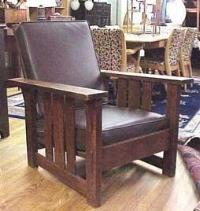
Stickley Brothers Morris Chair
Unquestionably one of the more stylish morris chairs
made by Stickley Brothers, we offer this signed Quaint/Stickley
Brothers morris chair in remarkably fine original condition and
finish. Catalogued in the reference material as model 631 1/2,
this model features three long extended slats on each side and
exposed temoms on all four legs; and measures seat height of 17"
and back height of 40"; and the seat itself measures 22"
square. Replaced leather cushions.
Price on application (SW1)
LIGHTING

Bradley & Hubbard Boudoir Lamp
Unusual 14 3/4" boudoir lamp by Bradley &
Hubbard, with floral metal overlay on shade.
Price $650.00 (JCL2)
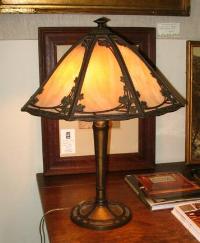
Bradley & Hubbard Lamp
Bradley & Hubbard 22" x 17" panel
lamp with metal overlay. One glass panel replaced (excellent glass
match).
Price $950.00 (JCL1)

Gustav Stickley Table Lamp
This signed Gustav Stickley table lamp was originally
crafted as a kerosene burning lamp, but has since been skilfully
and sensitively (no drilling etc)converted to electric usage.
Having a period Japanese wicker shade lined with an older yellow
material, this lamp is quite original with only the copper having
been gently cleaned some time ago. Wrought iron applied handles,
and vivid signature on the body. Overall Height (including chimney):
28"
Price on application (SL8)

Benedict Studios Hammered Copper / Mica Lamp
This lamp, though unsigned, is assuredly by Benedict
Studios of Syracuse N.Y. and is in extremely fine original patina
and condition (with the minor exception of what might be a replaced
socket). Ca 1912 Height: 14" approx / Shade diameter: 10"
Price on application (SL7)
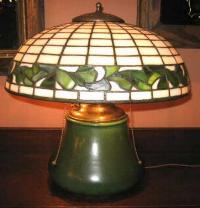
Bigelow & Kennard / Hampshire Pottery Table
Lamp
This arts and crafts period lamp consists of a signed
Hampshire Pottery (Keene, NH) base holding an unsigned Bigelow
& Kennard (Boston, MA)leaded shade. This was a combination
of companies known to collaborate at that period in time. The
shade has a simple stylized border design; and the base has a
complementary matte green color/glaze. Shade diameter: 16"
/ Overall height: 16" approx
Price on application (SL6)

Bradley and Hubbard Table Lamp
This fine Bradley and Hubbard lamp has a fine "frogskin"
finish indigenous to the higher quality B&H lamps produced
ca 1910. Having original high quality Murano (Italy) glass throughout,
this lamp was once a fuel burning lamp having the fuel tank (font)
surrounded by like glass as the shade, though never intended to
illuminate at the base. It has been electrified but does retain
the original font and chimney holder. The original wick mechanism
is, of course, absent. Height: 22 1/2" to top of chimney
/ Shade Diameter: 13 1/2"
Price on application (SL5)
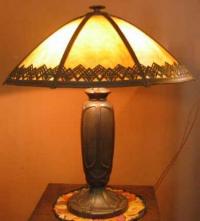
Bradley and Hubbard Table Lamp
This large Bradley and Hubbard Table lamp is in
exquisite original condition, having a warm amber glass shade
with a stylized metal overlay, and a cast metal base that complements
the shade well. Signed Bradly & Hubbard. Shade diameter: 22"
/ Overall Height: 24"
Price on application (SL4)

Leaded Table Lamp - Bigelow Studios
This completely original table lamp is signed on
the interior of the shade "Bigelow Studios", and was
sold by the firm of Bigelow and Kennard of Boston ca 1915. It
is constructed of a white opalescent glass in brickwork pattern
with a perimeter of stylized cherries and leaves in varying shades
of green and red, set upon a three socket base constructed of
bronze. In wonderful original condition but for a spider crack
in one of the white brickwork pieces (shown). Shade diameter:
16" / Overall height: 21" approx.
Price on application (SL3)
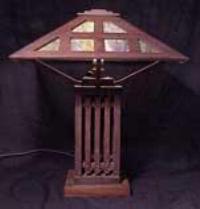
Prairie Style Table Lamp
This wood table lamp, constructed of black walnut,
displays a strong and dramatic Prairie style with the overstated
flat horizontal line of the shade held by elongated buttress style
shade supports; and the strong vertical linear slatted base. Fine
original condition. Ca 1915 Height: 22" / Shade Diameter:
17"
Price on application (SL2)
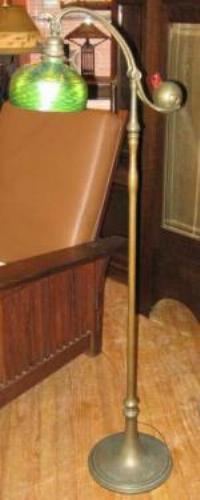
Tiffany Counterbalance Floor Lamp
This fully signed (shade and base) Tiffany floor
lamp is in extremely fine original condition with no flaws to
either the signed bronze base or this fine signed 7 inch damascene
shade. Features an adjustable double arm bridge with a ratcheting
shade tilt adjustment as well. Height @ apex: 55" approx.
Price on application (SL1)
POTTERY
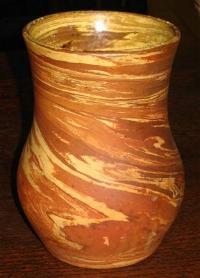
North State Pottery Vase
7" Tall North State Vase
Price $225.00 (JCP1)
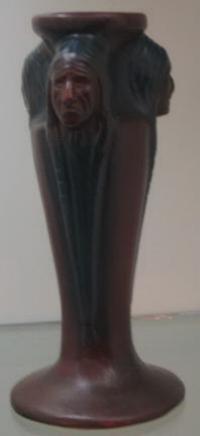
Van Briggle Vase
Van Briggle Vase circa 1920, with a repeating design
of three Indian heads. 10 3/4" tall. Signed.
Price $775.00 (JCP2)
A BRIEF HISTORY OF THE AMERICAN ARTS & CRAFTS MOVEMENT
Thank you to Hewn
& Hammered
GUSTAV STICKLEY AND CRAFTSMAN HOMES
At the turn of the last century a uniquely American tradition
of home design and furnishing appeared: clean in line, solid in
construction, choice in materials, and given to the aesthetic
of a life lived in harmony with nature. The living room at Craftsman
Farms nears full restoration to its original appearance. Many
of the historic furnishings have been restored to their original
locations during the Stickley era.
Gustav Stickley, the premier exponent of the movement in design
and decorative arts called Arts and Crafts, built in 1908-1910
what was first to be a school, and later became his home, on a
twenty-six acre site in Parsippany, near Morris Plains, in Morris
County. Along what is now Route 10 West, the site, known as Craftsman
Farms is a National Historical Landmark, and the log house Stickley
called home is a center for the study of the American Arts and
Crafts movement.
Stickley, having learned furniture making as a teenager, became
disillusioned by the poor quality of mass-market furniture available
in the late nineteenth century. Travelling in Europe, he was drawn
to the products and ideas produced by Arts and Crafts designers
internationally, which emphasized the natural beauty and durability
of wood. Stickley also recognized that the expanding American
middle class represented a reliable market for sturdy furniture
and accessories. The eventual product from Stickley's Craftsman
Workshops is known today as Mission furniture.
Stickley disseminated his products and ideas partly with the
aid of his monthly periodical, The Craftsman. The publication
contained articles about politics, industry, textiles and the
economics of house design and decoration; all designed to promote
the notion that Craftsman products, simple and functional, could
help ease the lives of their owners.
The main Log House at Craftsman Farms is an example and repository
of what Stickley himself called the 'straightforward' style. Influences
on this then-revolutionary fashion is apparent in the furnishings
and woodworking of Japanese, Shaker, and California Mission crafters.
Originally constructed as the central meeting hall for a boy's
farm school intended to inculcate the values he felt inherent
in the simplicity and solidity of his designs, the interior was
modified for use as his family living quarters. Logs used to build
the house were cut from trees on the property, transported to
the Stickley factory near his original home in Syracuse, New York
for staining and finishing, then returned to the site for final
construction. In what was an advocacy of family values in his
day, Stickley had five fireplaces constructed in the home in the
belief that a warm hearth would keep family members close. A hearth
at one end of the living room is inscribed "The lyf so short,
the craft so long to lerne."
Today, Craftsman Farms Foundation shares the Stickley vision
by interpreting his house and its restoration to visitors from
all over the world. Countless feet have crossed the threshold
of the old log house as carpenters, electricians, and plumbers
work their magic to return the residence to its 1911-1917 appearance.
The changes are dramatic. The dining room and living room walls
and chimneys have been stripped of the white paint used in later
years to "brighten" the interior. Oxidized portions
of the original wall finish remain, bringing the first floor one
step closer to its original appearance, tantalizing the viewer
to imagine the original sheen of the interior chestnut log walls.
Also stripped of their white coating, the chimney stones' raw
beauty is revealed, each stone carefully chosen for its hue of
color. Each of the house's diamond-paned casement windows was
built with its own interior framed screen, which have been replicated
as storm windows with ultra violet light protection for the interior.
Light glows from these windows. Artisans carefully replicated
the first floor's missing interior and exterior hammered copper
lanterns which hang again from their rightful places, generating
warm lantern light from replica Edison light bulbs.
Upstairs, the Stickley daughters' bedroom also approaches it
original character, described in 1911 as having "both delicacy
and strength... appropriate to the ideal of the modern woman.
The color scheme has a certain refinement. The walls are covered
with gray Japanese grasscloth, and the hearth is of dull blue
Grueby tiles with a brass hood". The walls and furniture
of the room are decorated with prints, photographs of friends
and family, and a Cornell pennant, probably from a beau. A racquet
may have leaned in the corner, casually thrown aside after a tennis
match. From this room visitors will gain a better understanding
of the property as the Stickley family home.
GREENE AND GREENE
Charles Sumner Greene (1868-1957) and Henry Mather Greene (1870-1954)
were brothers born in Brighton, Ohio, now part of Cincinnati.
The boys spent part of their childhood living on their mother's
family farm in West Virginia while their father, Thomas, attended
medical school in St. Louis, Missouri. The brothers developed
a love of nature during those West Virginia years that would be
ever-reflected in their art.
By the time the boys were teenagers, their father, now a respiratory
physician, had moved the family to St. Louis and enrolled the
boys in the Manual Training School of Washington University. Here,
beginning in 1883 and 1884, respectively, they studied woodworking,
metalworking, and toolmaking. The family lived in a small, poorly
ventilated apartment during those years, and their father's professional
concern with the need for sunlight and freely circulating fresh
air would come to influence them later in their work.
Their father decided for them that the two should become architects,
and at his urging, enrolled at the School of Architecture of the
Massachusetts Institute of Technology. They grudgingly studied
the traditional classic styles, hoping only to gain certification
for apprenticeships with architecture firms upon graduation, which
they accomplished - Henry finally settling in with the H. Langford
Warren firm, and Charles with Winslow and Wetherell, among others.
Then in 1893, their parents, who had moved to the "little
country town" of Pasadena, requested that their sons move
out to California and join them. The brothers did so, and the
cross-country trip proved fortuitous: while passing through Chicago,
they stopped at the World's Columbian Exhibition and for the first
time saw examples of Japanese architecture. Their immediate admiration
of the style would become a strong influence on their later designs.
Soon after their arrival in Pasadena, Charles and Henry set up
shop together, and the architecture firm of Greene & Greene
was born. Their art would culminate between 1907 and 1909 with
the construction of the "ultimate bungalows" - one of
which is the Gamble House in Pasadena.
The Gamble House
ROYCROFT
Roycroft is as much a state of mind as a place; this paraphrases
what Elbert Hubbard had in mind when he founded the utopian craft
community more than 100 years ago. The first Roycroft publication
was printed in 1895.
Originally devoted to the making of beautiful books in the manner
of William Morris, the Roycrofters soon developed a wide range
of arts and crafts items for sale. What they made to furnish and
decorate their expanding Roycroft Campus was soon being sold by
catalog.
The unique combination of Hubbard family, artisans, and workers
created a multi-level complex operation that included books, art,
education, music, and magazines.
The Book "Images of America The Roycroft Campus" by
Kitty Turgeon and Robert Rust explore the key factors that surround
what made Roycroft Campus fascinating social experiment and made
it eligible for a National Historic Landmark status. That designation
was given in March 1986.
Elbert Green Hubbard was born June 19, 1856, the third child
to a country doctor and his wife in Bloomington, Illinois. His
parents had moved west after their sojourn in western New York
on the Seneca Indian Reservation. Dr. Silas was from a large family
from Mayville, New York, on Chautauqua Lake. Juliana Reed Hubbard,
a young teacher, was from Buffalo, New York, the daughter of a
bookbinder. Elbert's father was a phrenologist, having studied
medicine at Castleton College in Vermont. Apparently, he was a
good doctor who never earned much money because he often gave
away his services.
With little formal schooling, Elbert Hubbard went to work selling
soap for a cousin in Chicago. He married Bertha Crawford in 1879.
They moved to Buffalo, where Elbert joined his sister Frances's
husband, John Larkin, as a partner in the Larkin Co., another
soap business. In 1883, the young Hubbard and their son Bert moved
to East Aurora, New York, and for ten years he commuted by train
to work in Buffalo.
His liaison with Alice Moore began in the late 1880s; she soon
encouraged his writing and subsequent "dropping out"
of the "establishment" or traditional world. After a
six-week stint at Harvard, he travelled to England to research
his Little Journeys to the Homes of the Great, soon to be published
by J. P. Putnam & Sons. A daughter, Miriam, was born to Elbert
and Alice in 1894, and only a year later, Katherine was born to
he and his wife Bertha. The man was torn between his respect and
love for the two women, but divorce and remarriage was the eventual
result between 1902 and 1904.
Elbert Hubbard founded the Roycroft Press in 1895, and two years
later, he began building what was to become the Roycroft Campus.
The success of his essay "A Message to Garcia" (1899)
catapulted him and the Roycroft to fame and enough fortune to
build his Roycroft Campus bigger and better and eventually, to
employ nearly 500 people.
After Alice and Elbert's death on the Lusitania in 1915, Elbert
II (Bert) and his wife, Alta, ran the enterprise differently,
but with a financial stability that was better than ever through
the 1920s. Changing tastes and especially, the Great Depression
dragged the Roycrofters into bankruptcy by 1938. Bert and Alta
lived on as prominent citizens of East Aurora / he even served
as mayor. Their children stayed in the area. Their only son, Elbert
Hubbard III (known as John), became a doctor; he is now retired.
Their youngest daughter, Nancy Hubbard Brady, was one of the founders
of the RALA; she died in 1982. Here daughter Linda carries on
the book business, "The House of Hubbards." Miriam's
six children dispersed to several places around the East Coast.
Here eldest daughter, Mary Roelofs Stott, became a noted author
and musician; there is an award fund in her name. One of the Hubbard's
farms, the Arden Farm, is still in Miriam's family; run by her
youngest son, Mark, it provides organic produce for the western
New York community.
The Roycroft Shops
BYRDCLIFFE
The Byrdcliffe Arts Colony was founded in 1903 in Woodstock,
New York by a wealthy Englishman named Ralph Radcliffe Whitehead,
along with his American wife Jane Byrd McCall and colleagues,
Bolton Brown (artist) and Hervey White (writer). Whitehead, Brown
and White searched the country looking for the perfect place to
build their art colony and settled on Woodstock because of its
natural beauty of the Catskill Mountains and its proximity to
New York City.
When the colony first opened, it had a metalworking shop, a pottery,
a woodworking shop, a large studio for Brown's art classes, a
dairy barn, guest houses, a dormitory for students, and White
Pines, the Whitehead's own house. The buildings resembled low
rambling Swiss chalets with dark stained pine siding, sloping
roofs with wide overhangs and ribbons of windows painted Byrdcliffe
blue.
White Pines, the Whiteheads' house, was the center of the Byrdcliffe
community. Many famous guests were entertained there including
poet Wallace Stevens, authors Will and Ariel Durant, naturalist
John Burroughs and dancer Isadora Duncan. Today, White Pines is
open to the public with a permanent Byrdcliffe exhibition. This
15-room country house is recognized as one of the finest architectural
examples of the American Arts and Crafts movement.
Over the years, Byrdcliffe has hosted celebrity visitors/guests
including actors Helen Hayes, Joanne Woodward and Chevy Chase,
painters Milton Avery, Philip Guston and George Bellows, sculptor
Eva Hesse, writer Thomas Mann, educator John Dewey and musicians
Bob Dylan and The Band.
The Byrdcliffe Arts Colony received its name as a combination
of Ralph Radlciffe Whitehead's middle name and his wife's, Jane
Byrd McCall Whitehead, middle name. The colony is still in operation
today and is located on 300 wooded acres with 35 unique Arts and
Crafts buildings on country pathways in Woodstock, New York. Byrdcliffe
is the oldest continuing arts colony in America.
The Byrdcliffe Colony
LIMBERT
Charles P. Limbert started making "Dutch Arts and Crafts"
style furniture and lighting at his Grand Rapids factory in 1902.
He always used the phrase "Arts and Crafts," and never
the word "mission" to describe his furniture. He was
a student of European furniture designs, acknowledging the influence
of the German and Austrian Secessionists on his work. British
(particularly Charles Rennie Macintosh), Japanese, and American
Prairie School influences are also evident in Limbert forms. Limbert
visited Europe on more than one occasion, and studied examples
of Dutch peasant furniture.
Limbert claimed that the original Spanish Mission Style was derived
from Dutch furniture designs. He employed a designer of Austrian
background, named Wm. Gohlke. Paul Horti, famous for Shop of the
Crafters designs, also designed some furniture for Limbert. Of
all American Arts and Crafts furniture makers, Limbert was perhaps
the best known for his use of decorative cutouts, including squares,
spades, hearts, etc. While Arts and Crafts enthusiasts may not
find all Limbert designs aesthetically pleasing, the good designs
are very good.
He emphasized high quality in materials and joinery techniques,
but his line was diverse enough to include outdoor furniture in
the Arts and Crafts style. Like Gustav Stickley, Limbert also
produced a short-lived line of inlayed furniture, and like Stickley's
the line was not a commercial success. That the Charles P. Limbert
Company stayed in business during and after WWI is a tribute to
the appeal and success of its products with consumers. Limbert's
furniture was also chosen to outfit the Old Faithful Inn at Yellowstone
National Park in 1906.
Charles P. Limbert was the son of a furniture dealer. He first
joined the furniture industry as a salesman, and in that capacity
he was highly regarded. In 1894 he started a Grand Rapids, Michigan
manufactury making chairs, all the while continuing to act as
a sales agent for other furniture makers. He is recognized for
having popularized the rustic furniture of Old Hickory of Martinsville,
Indiana.
He opened a factory in Holland, Michigan in 1906 where he produced
furniture until 1922, when ill health prompted him to sell off
his interest in the company. Limbert said that he wanted a more
healthy and productive location for his workers. The Holland factory
was a scenic site with indoor and outdoor recreational facilities
for the workforce. It was also accessible by interurban trolley
line from Grand Rapids.
Paul Kemner & Peggy Zdila
CHARLES ROHLFS
Drama in Design: The Life and Craft of Charles Rohlfs is the
first comprehensive study of the personal life and creative career
of Charles Rohlfs (1853-1936) and is the culmination of over a
decade of interest in Rohlfs by author Michael L. James, an independent
scholar in Buffalo, New York. This richly illustrated book, published
in conjunction with the 1994 exhibition "The Craftsmanship
of Charles Rohlfs" at the Burchfield Art Center, Buffalo,
will prove to be an important reference work, even if some of
its assertions about Rohlfs's place in the arts and crafts movement
and the influences on his work are questioned.
In a 1900 address to an arts and crafts conference, Rohlfs explained
that "the things produced in the glow of enthusiasm are the
things that have stood the test of time because they have been
natural to the producer"
(p. 93). His quotation aptly describes his own idiosyncratic furniture.
It received wide recognition in his lifetime, but it was then
left unexplored until the 1970s when scholars became interested
in the American arts and crafts movement.1 James contends that
lack of information about Rohlfs has caused his principles and
motivations to be poorly understood and has consequently left
him unrecognized by the general public. James states in his introduction
that his goal is to elevate Rohlfs's status as an artistic furniture
designer (p. 9)-a reputation once accorded him and still, the
author asserts, entirely deserved.
Drama in Design presents a great deal of new information on Rohlfs.2
Each succinct chapter reveals previously unknown details of his
life and knits a fascinating tale that well reflects his "glow
of enthusiasm" for all his endeavors. The text follows a
biographical format-the opening chapters detail Rohlfs's early
life and career, the text then explores his creative nature as
manifested in furniture, and it closes by outlining his personal
and civic efforts.
James fully recounts Rohlfs's acting career and his collaboration
with his wife, novelist Anna Katharine Green, topics only briefly
mentioned in earlier published information. Rohlfs began his artistic
career as a cast-iron stove and furnace designer in New York City
while attending night classes at Cooper Union and pursuing his
first true passion, acting. Rohlfs's 1877 stage debut was followed
by a brief tenure with the Boston Theater Company. Unable to attain
significant roles, however, Rohlfs retreated to a design career
and continued his self-study in acting-a pattern that continued
throughout his early career. By 1880, Rohlfs garnered some respectable
reviews and consequently attained roles in traveling performances
and held the lead role in several of his own productions. Critics
responded equivocally to his later performances, citing his "peculiar
interpretation" and display of "real dramatic power"
(p. 29). The same assessment might be made of his furniture, which
suggests the intimate and heretofore undocumented association
between Rohlfs's theatrical and furniture-making careers; drama
was essential to both.
James chronicles Rohlfs's cabinetmaking career from the earliest
indications of his interest in furniture in 1887 through the development
and growth of his company. Rohlfs initially made furniture for
his own apartment, but interest in his creations resulted in numerous
commissions. Rohlfs soon outgrew his modest attic work area and
opened his first shop in Buffalo, where he and his family had
settled in the late 1880s.
"The Sign of the Saw," the most extensive chapter in
the book, explores the production of Rohlfs's furniture, its distinguishing
characteristics, and the international recognition it achieved.
When Rohlfs's business expanded, he no longer constructed the
works but limited his role to designing furniture. He continued,
however, to assert his artistic philosophy in the production process.
He referred to his workmen as "fellow-laborers" and
believed their sentiments were integral to the manufacture of
the work: "to produce artistic furniture," he said,
"they 'must be in sympathy and work with the feeling that
they are part of the plan'" (p. 57). Unlike his contemporaries,
Rohlfs maintained a close relationship with the fabrication of
the object. After he completed the initial design, a scale model
of the object was presented to Rohlfs for approval. The manufacturing
process included hand and machine labor and resulted in aesthetically
unusual, even whimsical, forms, distinguished by Rohlfs's sinuous
motifs. Similar processes and enthusiasm were part of the production
scheme for other wares by Rohlfs, such as lamps and chafing dishes.
Rohlfs's work found increasing favor among an international audience,
as James's account documents. Rohlfs participated in numerous
national and international expositions. His acclaim was so far-reaching
that he received accolades from European royalty and numerous
commissions for entire room suites. The most well-documented Rohlfs
interior is the house he and his wife constructed in 1912. Drama
in Design contains outstanding images of the house. They depict
a diverse group of Rohlfs's objects in the setting for which they
were intended-he also designed the interior of the home including
wood and plaster work and light fixtures.
The book concludes with two chapters that summarize Rohlfs's
participation in various arts-related organizations, the patents
he developed during his lifetime, and the last decades of his
personal life. These chapters are visually rich, and the images,
combined with the wealth of details, lend insight into the personality
of a designer who was, and is, often considered eccentric. The
final section of Drama in Design reprints five speeches and interviews,
including "True and False in Furniture" (an address
given to a 1900 arts and crafts conference in Buffalo) and a 1902
speech given to an arts and crafts conference in Chautauqua, New
York. These selections illuminate Rohlfs's beliefs and document
that he never lost his flair for dramatic presentation. The closing
pages contain a bibliography and a checklist of the exhibition
at the Burchfield Art Center.
A closer look at some of the key assertions in Drama in Design
reveals its limitations. The chapter "Sources of Rohlfs'
Style" presents information on the stylistic influences on
Rohlfs, a topic that has surfaced but has not been developed in
prior publications. James suggests apparent "concessions
to derivation" in Rohlfs's work, including assimilation of
Moorish, medieval English, and Oriental motifs. He also acknowledges
previously made connections between Rohlfs's work and that of
architect Louis Sullivan and designer Edward Colonna but asserts
them to have been unlikely; rather, James argues, Rohlfs drew
on "ideas absorbed over a lifetime," which manifested
themselves in a fresh and unique manner in his work. James also
refutes the connection of the furniture to the mission (or arts
and crafts) style; Rohlfs himself claimed to prefer "my own
style (not 'Mission')"
(p. 44). James contends that "'the product of natural ideas'
aptly summarizes Rohlfs' work, as nature was the primary inspiration
for his craft." He supports this assertion with a thorough
discussion of Rohlfs's "reverence for wood grain" as
manifested in the arresting carved embellishment found on the
furniture.
Although Rohlfs's work illustrates a persuasive naturalistic
inspiration, combined with some of the aforementioned aesthetics,
James too readily accepts Rohlfs's assertion that "natural
ideas" and his own creative genius were the sources of his
designs. James easily dismisses other potential effects, noting
that "it is tempting to speculate on the possible influences
and connections among the multitude of artists and craftsmen .
. . [but] it is difficult to distinguish casual threads from a
collective exchange and merging of ideas" (p. 44). Yet with
such a great quantity of artistic activity in upstate New York,
combined with Rohlfs's design training, New York City upbringing,
and extensive European travels a decade earlier, it seems implausible
that he could have worked so free of other influences.
In the introduction, James expresses his intent to place Rohlfs
in the context of the arts and crafts movement, but by arguing
so persuasively that Rohlfs's work is difficult to categorize,
he undermines this goal. James maintains, "Although some
of Rohlfs' work does resemble the Mission style, the majority
of his furniture speaks for itself in disputing that connection"
(p. 44). He contends that Rohlfs's work may be more appropriately
"cited as an American expression of L'Art Nouveau, or . .
. a hybrid of that style and American Arts and Crafts" (p.
44). He offers no support for these claims by references to individual
works, however, and although the entire book is well illustrated
with photographs of the period and the furniture, at no time does
the text cite specific images. It leaves the interpretation of
the works solely to the reader. References to Rohlfs's house are
in the text, for example, but James does not discuss the specific
images.
James claims in the introduction that Rohlfs's furniture relates
to "the art furniture of today" and that he hopes greater
understanding of Rohlfs's life and craft "will establish
his place in the Arts and Crafts Movement." Unfortunately,
the book leaves both tasks undone. James discusses Rohlfs's philosophy
in the context of the arts and crafts movement, noting, for example,
that Rohlfs "identified himself with the arts and crafts
philosophy of the time" and that "his ideas strongly
parallel those of John Ruskin." Readers would have been given
a deeper understanding of Rohlfs's position in the movement, however,
if James had incorporated this discussion into the text and had
compared Rohlfs's work and philosophy with that of his arts and
crafts colleagues integral to the thesis. Further, Rohlfs explained
that he was not a reformer, yet his speeches to arts and crafts
societies included in the appendixes strongly promote the rhetoric
of the movement. He also adamantly distinguished his work from
the mission style, yet later we learn that he drew on the aesthetics
of the arts and crafts movement for the interior design of his
own home. According to the introduction of the book, Rohlfs's
"ideas, closely aligned with English Arts and Crafts principles,
evolved over time" (p.10). To what extent Rohlfs influenced
other reformers or designers, and to what degree he was influenced
by the English or American stylistic vocabulary of the movement
(in the use, for example, of natural materials and exposed joinery),
are not completely addressed.
Despite these limitations, Drama in Design offers ample new information
on the art and life of Charles Rohlfs. It is well presented, thoroughly
researched, and abundantly illustrated. James's efforts represent
the advancing scholarship initiated by earlier ground-breaking
exhibitions and catalogues. This study should certainly help bring
to light additional examples of Rohlfs's work. More importantly,
however, James's text makes an enigmatic character, his arts,
and his philosophy more accessible to a general audience through
a judicious balance of personal information and art historical
research.
Anna Tobin D'Ambrosio
Munson-Williams-Proctor Institute
WILL H. BRADLEY
Born in Boston, William Henry Bradley was largely self-taught
as an artist. He began working in a printer's shop at the age
of twelve in Ishpeming, Michigan, where his mother had moved in
1874 after the death of his father. This work experience would
be important in introducing the young man to the many issues of
typesetting, advertisements, and layout that would occupy him
in the years to come.
Bradley executed a number of designs to promote The Chap-Book,
a short-lived but important publication based in Chicago. His
1894 design for Chap-Book, titled The Twins, has been called the
first American Art Nouveau poster; this and other posters for
the magazine brought him widespread recognition and popularity.
In 1895 Bradley founded the Wayside Press in Springfield, Massachusetts,
and published a monthly arts periodical, Bradley: His Book. He
remained an active and important member of the graphic arts world
for the rest of his long life.
M. Lindsay
HARVEY ELLIS
Harvey Ellis is considered by many authorities to have been one
of the United States' most talented and influential architects.
In addition, he was known for his illustration work, his painting
and his furniture designs for the Stickley firm.
However, the private nature of the man has proved a difficult
barrier for researchers to surmount in documenting his work. Harvey
Ellis seems to have been the type of individual for whom the desire
for fame and fortune came in a distant second to his desire for
creative expression.
In the words of author Eileen Manning, "In order to approach
the work of Harvey Ellis, it is necessary to examine the relationships
that existed between draftsmen and architects during the latter
part of the nineteenth century…Harvey Ellis typifies the
journeyman draftsman." Journeymen draftsmen often moved from
city to city and from firm to firm. Ellis himself worked in Rochester,
Utica and areas of the Midwest. Much of Ellis' work was credited
to the supervising architects of the projects with which he was
associated, although the designs were his. Ellis himself seemed
uninterested in promoting his own name. In addition, personal
problems, including alcoholism, dogged him throughout his life.
Today, Ellis' work is recognized and celebrated, not only in Rochester
but also throughout the world.
Rochester Images
LOUIS H. SULLIVAN
Louis Sullivan was born in Boston, to an Irish-born father and
a Swiss-born mother both of whom immigrated to the United States
in the late 1850s. While attending high school Sullivan met Moses
Woolson, whose teachings made a lasting impression on him, and
nurtured him until his death. After graduating from High school,
Sullivan studied architecture briefly at the Massachusetts Institute
of Technology. Learning that he could both graduate from high
school a year early and pass up the first two years at the Massachusetts
Institute of Technology by passing a series of examinations, Sullivan
entered MIT at the age of 16. After one year of study, he moved
to Philadelphia and talked himself into a job with architect Frank
Furness.
The Depression of 1873 dried up much of Furness's work, and he
was forced to let Sullivan go. At that point Sullivan moved on
to Chicago in 1873 to take part in the building boom following
the Great Chicago Fire of 1871. He worked for William LeBaron
Jenney, the architect often credited with erecting the first steel-frame
building. After less than a year with Jenney, Sullivan moved to
Paris and studied at the École des Beaux-Arts for a year.
Renaissance art inspired Sullivan's mind, where he was influenced
to relate his architecture to emulate.
Michelangelo's spirit of creation rather than replicate the styles
of earlier periods. He returned to Chicago, not yet out of his
18th year. He began work for the firm of Joseph S. Johnston &
John Edelman as a draftsman. Johnston & Edleman were commissioned
for interior design of the Moody Tabernacle, which was completed
by Sullivan. In 1879 Dankmar Adler hired Sullivan; a year later,
he became a partner in the firm. This marked the beginning of
Sullivan's most productive years.
With a string of triumphs such as the 1889 Auditorium Building
in Chicago (where Adler and Sullivan reserved the top floor of
the tower for their own atelier), the 1891 Wainwright Building
in St. Louis and the 1899 on State Street in Chicago, Louis Sullivan
was the first architect to find the right form for a steel high-rise.
Louis Sullivan lived by the phrase "form follows function".
The steel girder was the form for the steel high-rise. This new
way of constructing buildings pushed them up rather than out.
The steel frame allowed taller buildings with larger windows,
which meant more interior daylighting, and more usable floor space.
The technical limits of masonry had always imposed formal constraints;
those constraints were suddenly gone. None of the historical precedents
were any help, and this new freedom created a kind of technical
and stylistic crisis.
Sullivan was the first to cope with that crisis. He addressed
it by embracing the changes that came with the steel frame, creating
a grammar of form for the high rise (base, shaft, and pediment),
simplifying the appearance of the building by using ornament selectively,
breaking away from historical styles and using his own intricate
flora designs, using that ornament in vertical bands to draw the
eye upwards and emphasize the building's verticality, and relating
the shape of the building to its purpose. All this was revolutionary,
appealingly honest, and commercially successful.
In 1890 Sullivan was one of the ten architects, five from the
Eastern US and five from the Western US, chosen to build a major
structure for the "White City", the World's Columbian
Exposition, held in Chicago in 1893. Sullivan's massive Transportation
Building and huge arched "Golden Door" stood out as
the only forward-looking design in a sea of Beaux-Arts historical
copies, and the only gorgeously multicolored facade in the White
City. Sullivan and fair director Daniel Burnham were vocal about
their displeasure with each other. Sullivan claimed that the fair
set the course of American architecture back by two decades. His
was the only building to receive extensive recognition outside
America, receiving three medals from the Union Centrale des Artes
Decoratifs the following year.
Adler and Sullivan broke their partnership after the Gauranty
Building. Afterwards Sullivan went into a twenty-year-long financial
and emotional decline, beset by alcoholism and chronic financial
problems. He was awarded several commissions for small-town Midwestern
banks (see below), wrote books, and in 1922 appeared as a critic
of Raymond Hood's winning entry for the Tribune Tower competition,
a steel-frame tower dressed in Gothic stonework that Sullivan
found a shameful piece of historicism. He and former understudy
Frank Lloyd Wright reconciled in time for Wright to help fund
Sullivan's funeral after he died, poor and alone, in a Chicago
hotel room. A modest headstone marks his final resting spot in
Uptown's Graceland Cemetery.
Sullivan's legacy is contradictory. He is the first modernist.
His stripped-down, technology-driven, forward-looking designs
clearly anticipate the issues and solutions of Modernism. In his
last years, Sullivan seemed willing to abandon ornament altogether
in favor of honest massing; in fact, Adolf Loos, the author of
the seminal manifesto "Ornament and Crime", had worked
in Sullivan's office. But to experience Sullivan's built work
is to experience the irresistible appeal of his incredible designs,
the vertical bands on the Wainwright Building, the burst of welcoming
Art Nouveau ironwork on the corner entrance of the Carson Pirie
Scott store, the (lost) terra cotta griffins and porthole windows
on the Union Trust building, the white angels of the Bayard Building.
Except for some designs by his long time draftsman George Grant
Elmslie, and the occasional tribute to Sullivan such as Schmit,
Garden and Martin's First National Bank in Pueblo, Colorado (built
across the street from Adler and Sullivan's Pueblo Opera House),
his style is unique. A visit to the preserved Chicago Stock Exchange
trading floor, now at the Art Institute of Chicago, is proof of
the immediate and visceral power of the ornament that he used
so selectively.
Wikipedia
GEORGE GRANT ELMSLIE
George Grant Elmslie was born in Aberdeenshire, Scotland on February
20, 1871 and emigrated to Chicago in 1884. He began his apprenticeship
in the office of William LeBaron Jenney, who is known for being
the originator of the steel frame skeleton used in modern building
construction. In 1887 he joined Frank Lloyd Wright and George
Maher in the office of Joseph Lyman Silsbee. After Wright left
to go to work for Dankmar Adler & Louis Sullivan in 1887 he
recommended Elmslie to Sullivan. And two years later he joined
Wright at Adler & Sullivan. That recommendation led to a 20
year association between Elmslie and Sullivan. Elmslie was Sullivan's
chief draftsman and ornamental designer. He detailed the ornamentation
for Sullivan's Wainright building in St. Louis, the Schlesinger
& Mayer (currently known as Carson Pirie Scott) Department
store in Chicago and the National Farmers Bank in Owantonna, Minnesota.
In 1909, after declining an offer from Frank Lloyd Wright to
take over his Oak Park studio, Elmslie left Sullivan's declining
practice to join the firm of William Gray Purcell and George Feick
Jr. in Minneapolis, Minnesota. Elmslie had met Purcell during
Purcell's short stay in Sullivan's office in 1903. The firm was
known for designing churches, residences and various types of
civic and commercial buildings throughout California, Connecticut,
Massachusetts and the Midwest. In 1913 George Feick Jr. left the
firm, while Purcell and Elmslie continued their partnership officially
until 1922. The new partnership of Purcell and Elmslie continued
to design numerous banks across the Midwest as well as the Woodbury
County Courthouse in Sioux City, Iowa in collaboration with former
Sullivan protégé William L. Steele. Over the course
of a decade the firm executed over 70 buildings along with numerous
other unrealized designs, making them the most productive of the
Prairie School architects.
In private practice Elmslie concentrated primarily on commercial
designs. As his commissions began to dwindle he sought work with
William S. Hutton and helped him with the design of the Washington
Irving, the Oliver Morton and the Thomas Edison Schools in Hammond,
Indiana, and also the design of Thornton Township High School
in Calumet City, Illinois.
Elmslie was awarded fellowship status by the American Institute
of Architects in 1947. He spent his last years writing articles
and giving an occasional talk. Elmslie died on April 23, 1952
and was buried in Graceland Cemetery in Chicago.
Prairie Styles
GEORGE WASHINGTON MAHER
George Washington Maher was born in Mill Creek, West Virginia,
on December 25, 1864. During his teens he apprenticed to prominent
Chicago architects Augustus Bauer and Henry Hill. Maher joined
the office of Shingle style architect J. L. Silsbee as a draftsman
in 1887, where he worked with fellow draftsman Frank Lloyd Wright.
In 1888 Maher formed a short-lived partnership with Cecil Corwin.
After Corwin left, Maher practiced alone until 1914, when his
son Philip joined him for a brief period. After the war the firm
became George W. Maher and Son.
During the 1890s Maher worked in a variety of styles. His Shingle
and Queen Anne projects were widely reviewed in the journal Inland
Architect during this period. Maher modeled his design for the
Fresno Library and Water Tower (1894) on a Medieval Romanesque
tower. By the late 1890s Maher's work began to reflect characteristics
of the Prairie style. He was one of the pioneer Prairie style
architects along with Frank Lloyd Wright, Purcell & Elmslie,
and Walter Burley Griffin.
Maher's most important and productive period came after 1904.
His bold and idiosyncratic residential interpretations of the
Prairie ideal were built throughout Chicago's suburbs, including
Oak Park, Evanston, Kenilworth, and Winnetka. He developed the
campus plan for Northwestern University in 1907 and designed Swift
Hall and Patten Gymnasium on that campus. He also did a great
deal of work in Wausau, Wisconsin.
After World War I, Maher became a vocal proponent of community
planning and prepared development plans for Glencoe and Kenilworth.
He is also credited with forming the committee that launched the
first efforts to restore the Fine Arts Building designed by Charles
Atwood for the 1893 Columbian Exposition at Chicago.
Subject to bouts of depression all his life, Maher became despondent
in 1925 and never fully recovered. He committed suicide on September
12, 1926.
John Edward Powell
FRANK LLOYD WRIGHT
The Frank Lloyd Wright School of Architecture was formally initiated
in 1932 when twenty-three apprentices came to live and learn at
Taliesin. The sources of this educational philosophy have roots
that go back much further than the '30s. The program of the School,
while remaining remarkably true to its heritage, has evolved through
experience and the need to address changing times.
In 1931 Frank and Olgivanna Lloyd Wright circulated a prospectus
to an international group of distinguished scholars, artists,
and friends, announcing their plan to form a school at Taliesin
in Spring Green, Wisconsin to "Learn by Doing."
"The fine arts, so called," they asserted, "should
stand at the center as inspiration grouped about architecture
. . . . (of which landscape and the decorative arts would be a
division)." Education at Taliesin would emphasize painting,
sculpture, music, drama, and dance "in their places as divisions
of architecture."
Each of these elements of the fine arts, as the Wrights conceived
them, would lead to broader learning: "Drama would be studied
as the essential structure of all great literature;" while
"Music would mean the fundamental study of sound and rhythm
as an emotional reaction both as to original character and present
nature." They anticipated a core faculty, "resident
foremen", at Taliesin supplemented by "a guest-system
of visitation, consultation and criticism" and faculty from
the "nearest university" who would make philosophy and
psychology and other disciplines available "by extension
work." The "Wisconsin Idea" at the University of
Wisconsin conceived of the entire State as a classroom, and the
Wrights with close friends at the University proposed to make
full use of it.
The students, or "apprentices," would round out their
education in the spirit of Tolstoy's "What to Do." "The
entire work of feeding and caring for the student body so far
as possible should be done by itself . . . work in the gardens,
fields, animal husbandry, laundry, cooking, cleaning, serving
should rotate among the students according to some plan that would
make them all do their bit with each kind of work at some time."
The ambitious plan for an endowed school exceeded the Wright's
capacity to attract funds in the second full year of the Great
Depression. So the next year, 1932, they issued a more modest
circular announcing the formation of the Taliesin Fellowship and
inviting young people to venture to Taliesin. The Fellowship would
organize around the principles they had articulated in 1931, and
the program now called the Frank Lloyd Wright School of Architecture,
has generally evolved along these lines.
But the sources of these ideas go back much further than the
early 1930s. They rested on the Wrights' own experience.
In 1886, Jane and Nell Lloyd-Jones, Frank Lloyd Wright's aunts,
founded the Hillside Home School, a coeducational country boarding
school dedicated to education of children, based on the principle
of "Learning by Doing", a radical departure from most
educational practices in those times. This philosophy made a profound
impact on Frank Lloyd Wright, himself an indifferent student impatient
with formal academic requirements and the rigid educational settings
of his youth. After a brief stay at the University of Wisconsin,
he left Madison to learn the profession of architecture in active
Chicago offices. When he opened his own independent practice,
Frank Lloyd Wright strongly supported the traditional training
of architects in the apprentice system which he, himself, had
experienced. Apprentice draftsmen and women always worked in his
Oak Park Studio.
After the closing of the Hillside Home School in 1915, for which
he had designed buildings and the Romeo & Juliet windmill,
Frank Lloyd Wright continually pursued the idea of establishing
a school for architects using the Hillside Home School buildings.
By then he had built Taliesin on a nearby hillside and had taken
up residence there. In 1926, he invited the internationally known
architect H. Th. Wijdeveld to join him in establishing a school.
Frank Lloyd Wright had observed educational experiments in the
United States and abroad, and the Arts and Crafts movement had
clearly influenced his thinking. During a visit to Taliesin, after
observing the condition of the Hillside Home School buildings,
Wijdeveld declared the idea impossible to achieve, especially
because of the appearance of the old, abandoned and vandalized
Hillside Home School buildings, then unused for over a decade.
In 1928, Frank Lloyd Wright and his new, dynamic wife, Olgivanna,
decided to repair the damage at Hillside Home School and reopen
it as an institution devoted to architecture and the allied arts.
Olgivanna Lloyd Wright encouraged and broadened her husband's
interest in education. The ninth and last child of an aristocratic
Montenegran family, she grew up in a cultural and stimulating
environment. Her mother, a crusading politician, served as a military
leader, setting an example as a woman of accomplishment and serious
purpose. Trained first in a progressive private school where Olgivanna
learned both French and Russian, she eventually came under the
tutelage of George Ivanovitch Gurdjieff. This charismatic mystic
created the Institute for the Harmonious Development of Man at
Fontainebleau, outside of Paris. Based on his philosophy of spiritual
development, Gurdjieff's school stressed hard work, self-discipline,
sacrifices and suffering, self-awareness, and conscious effort,
often through performance. Olgivanna excelled in music and dance,
and she came to the United States ready to put her learning into
practice.
Frank Lloyd Wright readily accepted her ideas and adopted as
his own her stress on the importance of the holistic development
of mind, heart, and body as the essence of an educated person.
The first twenty-three apprentices who formed the Taliesin Fellowship
in 1932 and other pioneers who joined them in the early 1930's
included some remarkably talented men and women. At first, Frank
Lloyd Wright had few commissions through which to teach the apprentices,
and he put them to work in the construction, operations and maintenance
of the school. The apprentices quarried the stone and burned limestone
and sifted sand from the adjacent Wisconsin River to make mortar.
They cut trees and sawed them into dimensional lumber, and along
with the masonry, built the large studio, now on the National
Register of Historic Places, that still serves as the center of
learning on the Spring Green campus and as an active architectural
studio. The apprentices worked on all aspects of life at Taliesin,
developing a largely self-sufficient school and community that
operated successfully with a very low budget.
Surrounded by bright, committed and energetic apprentices, Frank
Lloyd Wright's career as an architect found new vigor, and soon
the students could learn as they worked on some of the most innovative
buildings in America. The celebrated master of the Prairie School
had expanded his vocabulary, and apprentices under his direction
created renderings, made models, did the engineering and produced
construction drawings. They supervised construction on projects
like the Johnson Wax headquarters (Racine, WI), Fallingwater (Bear
Run, PA) and the first Usonian houses. They did the first perspectives
of the Guggenheim Museum (New York, NY) and Monona Terrace (Madison,
WI). The Taliesin Fellowship had with astonishing speed developed
into an exciting architectural laboratory which attracted some
of the nation's best work and hosted many of the world's great
artists and great minds. In 1940 the Museum of Modern Art exhibited
some of the models made by the students.
In the winter of 1935 Frank and Olgivanna Lloyd Wright moved
the entire Fellowship to Chandler, Arizona, where they constructed
the model of Broadacre City, Frank Lloyd Wright's concept of the
integration of living and working in successfully planned communities.
This first winter in Arizona inaugurated the tradition of moving
the School between Wisconsin and Arizona that still continues.
After the first two winters in temporary quarters, he purchased
land in Scottsdale and, in 1937, with the apprentices, began the
construction of a new kind of desert architecture at Taliesin
West.
As the work of the architectural office expanded, some of the
apprentices decided to stay at Taliesin, continue their professional
development as practicing architects in Frank Lloyd Wright's "firm,"
marry and raise families. Others left Taliesin and began successful
careers in architecture with other firms and on their own. New
apprentices replaced those who left; the talented group who stayed
became the Senior Fellowship. They also became the "resident
foremen," the faculty that the Wrights had envisioned.
Following a hiatus during World War II when new construction all
but ceased and rationing precluded the cross country excursions
between Arizona and Wisconsin, the demand for Frank Lloyd Wright's
services returned in force and accelerated until his death in
1959. The post-war influx of commissions reaffirmed the need for
permanent members of the Fellowship to produce architectural work
and to mentor the growing number of young men and women seeking
to experience the concepts embodied in organic architecture. During
these exciting years, the fellows and the apprentices worked on
more than 100 houses, including the Usonian Automatics and other
experiments with concrete blocks. They also worked on the Guggenheim
Museum, the Price Tower (Bartlesville, OK), the Florida Southern
College campus (Lakeland, FL), the Grady Gammage Auditorium (Tempe,
AZ), the Annunciation Green Orthodox Church (Wauwatosa, WI), several
planned communities (Pleasantville, NY and Kalamazoo, MI) and
the expansion of Taliesin West.
Young men and women could come to Taliesin and get first hand
training working with outstanding architects on some of the nation's
most visible and important projects. With the growing life at
Taliesin they would also participate in music, drama and other
fine and performing arts. They interacted with the constant parade
of the world's best minds who came to visit the Wrights and the
Fellowship. When their skills developed and they had sufficient
experience, some would stay and join the Senior Fellowship, but
most would leave, pass the boards and become registered, practicing
architects. In recent years, these former apprentices have organized
as the Taliesin Fellows. They hold reunions, conduct meetings,
publish a journal, and, in 1996, became the official alumni organization
of the Frank Lloyd Wright School of Architecture.
After Frank Lloyd Wright's death, the Senior Fellows incorporated
an architectural firm to continue the practice and to mentor the
apprentices. These activities now took place under the umbrella
of The Frank Lloyd Wright Foundation which Frank Lloyd Wright
established in 1940 by deeding to it all of his personal and intellectual
property. His will confirmed his gift to the Foundation, and after
1959 it became the governing entity for all of the activities
at Taliesin with Olgivanna Lloyd Wright serving as its president
until her death in 1985.
As with other professions, the practice of architecture has become
increasingly structured. The American Institute of Architects
(AIA), the National Architectural Accrediting Board (NAAB), the
National Council of Architecture Registration Boards (NCARB),
and other organizations which govern the standards of architectural
practice, increasingly required graduation from an accredited
institution of higher education and an accredited architectural
program as a pre-requisite to sit for the Architectural Registration
Examination (ARE). These exams have become the sole gateway to
licensure and professional practice for the majority of the States.
In response to this changing climate, the Foundation stepped forward
to formalize the apprenticeship program into the Frank Lloyd Wright
School of Architecture. Apprentices, however talented and well
trained, could not become licensed architects in many states without
the approved degree.
The educational program, under the direction of new academic
administration positions, adapted most of the basic tenets of
"Learning by Doing" and the educational philosophy that
underlay the Taliesin Fellowship to the range of institutional
characteristics required of an accredited institution of higher
education. The new Frank Lloyd Wright School of Architecture expanded
academic offerings and experiences, developed a library, added
facilities, and placed the essential elements of student life
- counseling and advising, admissions, and financial aid - on
a much more formal basis. Both campuses, which have earned National
Historic Landmarks status from the National Park Service, now
have many of the elements of a small college. From 1985 until
1996 the School underwent a rigorous process of reporting towards
accreditation, which was earned successfully at both the Institutional
level and the Professional Architectural level (see accreditation).
A School Endowment has been developed and is continuing to grow.
An Alumni association, the Taliesin Fellows, provides graduates
a vibrant professional and personal network.
The basic elements of life, learning, and work at Taliesin have
remained in much the same relationship as they began and evolved
under the leadership of the Wrights. The apprentices continue
to learn experientially, and they do much of the work of feeding
and caring for themselves and of maintenance and construction
on their two campuses in Wisconsin and Arizona. Their learning
laboratory requires the active, successful architectural practice
of local architects to provide projects in many states and abroad.
The design and construction of houses, health care and recreational
facilities, and major commercial and civic structures offer the
apprentices a wide range of experience. In turn, professional
architects mentor and teach young apprentices. As in the Wrights'
lifetime, Taliesin continues to attract a steady procession of
scholars, authors, artists, performers and others who come to
teach and to interact with the life of Taliesin. With virtually
100 percent of its graduates actively practicing architecture,
the Frank Lloyd Wright School of Architecture builds upon the
foundation of the educational ideas of Frank and Olgivanna Lloyd
Wright and successfully adapts them to changing external and internal
conditions.
Taliesin
ROBERT R JARVIE
Robert Riddle Jarvie worked at the Chicago Department of Transportation
in the late 19th century, and as a hobby began making lanterns
and the tall, graceful candlesticks for which he is best known.
In 1904 he left his job and started the Jarvie Shop in downtown
Chicago. A premier metalsmith of the Arts and Crafts movement,
he applied influences from Prairie School architecture and ornamentation
and from Art Nouveau in recreating early American lighting fixtures,
especially candlesticks. During seven short years from 1905 to
1912 Robert R. Jarvie produced an entire line of candlesticks
that transformed a utilitarian article into a decorative work
of art. Unfortunately, the World War One years took their toll
on his business, and in 1920 he closed his shop.
Mackintosh Design
ERNEST A. BATCHELDER
Ernest A. Batchelder (1875-1957) was an artist and educator who
made Southern California his home in the early 20th century. He
is famous as a maker of art tiles.
Batchelder came to Pasadena, California, in the early 1900s to
teach, and became director of the art department at Throop Polytechnic
Institute, the predecessor of the California Institute of Technology.
His life took a turn in 1909 when, behind his house overlooking
the Arroyo Seco, he built a kiln and entered the business of creating
hand-crafted art tiles. The tiles were hugely popular, and by
the 1920s, Batchelder's tiles could be found in homes and buildings
across the United States. Batchelder's prominence in Southern
California's art community included his involvement in the founding
of the Pasadena Art Institute and his membership in the Pasadena
Society of Artists.
The house that Batchelder built in Pasadena, California, in the
early 1900s, and where he set up his first kiln, is listed on
the National Register of Historic Places.
The current resident, Dr. Robert Winter, wrote the definitive
Batchelder history, Batchelder Tilemaker (Balcony Press, 1999,
112 pp, ISBN 1890449032). Although the house is not open to the
public, some Batchelder tiles, stamped with heraldic animals and
figures, may be found on the walkway in front of the dwelling.
Answers
GEORGE OHR
George Ohr was born in Biloxi, Mississippi in 1857. In 1879,
Joseph Meyer
offered to teach Ohr the potter¹s trade. Ohr¹s family
knew potters Francois
and Joseph Meyer, a father and son from France who settled in
Biloxi, but
later moved to New Orleans. In New Orleans, Joseph Meyer taught
George Ohr
to use materials at hand, including local clays, to build rudimentary
wood-burning kilns, and the formulae for old-world lead glazes.
They
produced utilitarian pottery wares and novelties for the tourist
trade.
George said he "took to pottery like a duck takes to water."
In 1882, Ohr
returned to Biloxi, to build his first pottery. In 1884, he exhibited
over
600 pieces in the World¹s Industrial and Cotton Centennial
Exposition in New
Orleans. He used state fairs, international expositions and trade
fairs to
exhibit and sell his work.
In 1888, William and Ellsworth Woodward started the New Orleans
Art Pottery
Company and asked Joseph Meyer to be the pottery¹s thrower.
Meyer asked Ohr
to assist him. The New Orleans Art Pottery Company dissolved and
became the
New Orleans Art Pottery Club, which engaged Ohr and Meyer for
over two
years, until the Woodward brothers decided to form the art department
of
Newcomb College (now part of Tulane University). Newcomb College
Pottery
prided itself on producing "no two alike." Ohr used
this philosophy to his
advantage. It became his mantra and described the unique quality
of his "mud
babies." Ohr returned to Biloxi, but remained involved with
the New Orleans
Art Pottery/Newcomb College endeavor through 1896.
George had married Josephine Gehring in 1888 and in 1890 created
a new
pottery, the Biloxi Art and Novelty Pottery. With his long moustache
and
offbeat sense of humor, George developed an eccentric persona.
He and
Josephine had ten children, but only five survived to adulthood.
Many of
Ohr's family remained in Biloxi, and today they make up a number
of the
oldest families on the Gulf Coast.
George's new pottery buildings burned in 1894, and over 10,000
works were
destroyed. Ohr's life was a study in stamina and resilience; he
always
persevered and started over. Despite his reputation for eccentricity,
George
Ohr was a hard worker. In the later part of his life, he produced
quality
art pottery that would be appreciated and remembered for centuries.
George
cultivated the idea that he was crazy, calling himself "The
Mad Potter of
Biloxi." He said that he was "unrivaled" or "unequalled"
and was, by his
own estimation, the "world¹s greatest potter."
His antics, self-promotion,
and playful spirit are what people remember, rather than what
was more
likely the case, a determined artist who sought to create attention
to his
creative production through his eccentric character.
Ohr's skills exploded when he became an "artist-potter."
His claim there
were "no two alike" was true. The pinched, folded and
twisted clay forms,
thinness of the clay wall, fluidity of form, tendril-like handles,
and
freshness of Ohr's creations illustrate a technical skill that
is still
unrivaled. One hundred years later, potters marvel at his skill
and cannot
rightly say exactly how it was done. Critics of the day praised
Ohr's
glazes, but as his admiration for pure forms executed in clay
increased, he
left many pieces unglazed in bisque form. He believed only in
this state
could the form be clearly perceived. Today we have a legacy of
Ohr's bisque
pieces that act as a sampler of his pinches, folds, and fabulously
thin-walled clay creations.
Though he was recognized as an artist to some extent, it was
only at the
1904 St. Louis World's Fair, that he received any official awards,
the
Silver Medal. He felt he was unappreciated, misunderstood, and
lacked a
lasting reputation. To combat the feeling of having no artistic
" immortality," in 1900 he addressed a box of work to
the Smithsonian
Institution, with it an inscription, "I am the potter who
was."
By 1907, Ohr's health began to fail. In 1910, he turned over
the building to
his son for an auto repair shop, but in a final stroke of humor,
Ohr named
it the "Ohr Boys Aut2 Repair Shop." George took to riding
a motorcycle in
his last days, with moustache flying. He died in 1918.
In the late Sixties, Jim Carpenter, an antique dealer, came to
Biloxi in
search of parts for antique cars and was directed to the Aut2
Repair Shop.
He was shown boxes of George Ohr's work. After negotiating for
several
years, Carpenter bought the entire lot of work, took it home to
New Jersey,
and started slowly selling it to the rising group of collectors
interested
in the "Mad Potter of Biloxi." In 1973, Carpenter saw
to it that the box
addressed to the Smithsonian was delivered. In a turn of events
that would
have pleased George Ohr enormously, the museum bearing his name
and
celebrating his genius became an affiliate of the Smithsonian
Institution in
2002. The interest in Ohr's work that was rekindled with Carpenter's
purchase continues to escalate today, and now George Ohr is considered
a
genius with pottery, "pushing the expressionistic limits
of clay to its
limits."
George Ohr Museum
GRUEBY
William H. Grueby (1867-1925) founded the Grueby Faience Company
in 1897 in Boston, Massachusetts. Grueby was a ceramic artist
who had been experimenting with more traditional styles when he
travelled to Chicago to attend the World's Columbian Exposition
of 1893. At that venue, Grueby was exposed for the first time
to the new matte glazes being introduced by French artisans around
that time. Upon his return to his Boston home, Grueby founded
the company and began a period of about five years during which
he experimented and perfected his own matte pottery glazes.
Focusing mostly on art pottery vases, he introduced his first
line of matte glaze wares in 1898; these were different than anything
which had been on the market before, and colors of green, pink,
aqua, and yellow were introduced in the new glazes. Of the new
color glazes, the matte green most associated with Grueby pottery
was the most unique and popular and to large degree remains so
today. Soon thereafter, Grueby began working with other top artisans
and manufacturers such as Gustav Stickley and Louis Comfort Tiffany.
Stickley mission style Arts and Crafts furniture was a perfect
complement to Grueby's pottery lines, and they were often displayed
together in showrooms, expositions, and trade fairs. As further
evidence of the synergies between these companies, Grueby lamps
and vases were also featured in Stickley catalogues and in magazines
devoted to mission style arts and crafts.
While less obvious artistically, it is also interesting to note
the pairing of Grueby ceramic lamp bases with Tiffany Studios
glass lamp shades, a combination that is quite rare and highly
collected in today's market. Like many manufacturers entering
the industrial age, Grueby works were frequently copied, and much
less expensive works were offered to a mass market with similar
but admittedly inferior glazes. Nevertheless, the competition
represented by the mass market production of similar glazes and
styles had a major financial impact on Grueby's fortunes, leading
to the bankruptcy of the company in 1909. Grueby emerged from
bankruptcy shortly thereafter, and they continued to offer limited
production runs of ceramic pottery, statuary, and tiles for another
ten years before closing the doors in 1920.
Collectics
FULPER POTTERY
The company that became the Fulper Pottery Company was originally
founded as the Samuel Hill Pottery of Flemington, New Jersey in
1815, where Fulper founder Abraham Fulper worked. Through talent
and hard work, Abraham soon became a partner in the firm with
its original founder and ultimately purchased it in 1860 following
Samuel Hill's death in 1858. Upon Abraham's death, his sons reincorporated
the company in 1899 under the name of Fulper Pottery Company.
Abraham Fulper's grandson, William H. Fulper II, began producing
art pottery with the Vasekraft line in 1909, and the company soon
became known for its creativity in design and its experimentation
with new and unique glazes. Moving well beyond vases, Fulper began
making a wide variety of household items including bookends, jugs,
bowls, beer mugs, candleholders, lamps, perfume and boudoir lamps,
desk accessories, and tobacco jars.
Whimsical pieces of fancy were created in the form of people,
animals, and objects both real and imaginary, many with thick,
rich glazes that seemed to blend colors and run into new shapes
and patterns. Fulper was created in the midst of the arts and
crafts movement, but they were concerned that production techniques
reflecting the values of the American arts and crafts movement
of hand craftsmanship would make their production unaffordable
for the general population. As such, Fulper made their pottery
in molds versus being hand thorwn on a wheel by a master pottery.
They envisioned their market differentiation in the uniqueness
and creativity of their glaze lines. In about 1910, Martin Stangl
of later individual fame joined Fulper in even more radical glaze
experimentation and new forms, raising the profile of the company
to a national market and winning various awards at art ware exhibitions
such as the San Francisco Panama/Pacific exposition of 1915.
The Vasekraft line remained popular right through World War I,
and its designs retained an aura of innovation. Nevertheless,
Fulper never received the critical acclaim that hand crafted arts
and crafts potteries of the time such as Grueby and Rookwood achieved,
and dependence on glazes ensured that no two pieces were identical,
leading to inconsistent quality in production. Fulper did reasonably
well in the market and expanded production in 1928, but just two
years later in 1930 following a fire at the factory Stangl purchased
the company as his base from which he continued producing kitchenware
and other pottery. Nevertheless, Fulper production of art pottery
never really recovered from the war years and their forays into
mass production, and art pottery production ceased by about 1934.
Today, values are primarily determined by form and glaze, with
the most rare and vibrant glazes bringing by far the most money
in the marketplace. Fulper experimented with insets of stained
glass and other materials into their pottery during the art production
years, and these pieces of more unique design being especially
well collected. Age is also important to Fulper value, and various
marks were used over the years which help to date the production.
A vertical FULPER in ink was the most common mark during the early
Vasekraft years of 1909 until about 1915, a raised vertical FULPER
in a rectangle was used from 1915 until 1922, a vertical FULPER
in ink but with oriental style characters in a rectangle was used
from 1922 until 1928, and an impressed horizontal FULPER along
with most typically a model number was used from 1928 until art
pottery production stopped in 1935.